|
|
|
 |
 |
 |
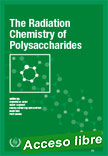 |
The Radiation Chemistry of Polysaccharides
IAEA Non-serial Publications, 2016, 467 p.
This publication provides the background and compiles the most recent research findings as well as detailing development activities relating to the development of radiation processed products made of natural polymers. Successes clearly indicate that the radiation processing of natural polymers has emerged as an exciting area where the unique characteristics of these polymeric materials can be exploited for a variety of practical applications in agriculture, healthcare, industry and the environment. |
Extraído de: http://pub.iaea.org/books/IAEABooks/10843/The-Radiation-Chemistry-of-Polysaccharides
|
 |
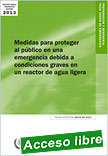 |
Medidas para Proteger al Público en una Emergencia Debida a Condiciones Graves en un Reactor de Agua Ligera
IAEA Emergency Preparedness and Response, 2016, 156 p.
La presente publicación tiene por objetivo facilitar la comprensión de las medidas que son necesarias para proteger al público entre los responsables de adoptar y aplicar decisiones ante la declaración de una emergencia en un reactor de agua ligera (LWR) o en una piscina de combustible gastado. La publicación sirve de base para elaborar en la etapa de preparación los instrumentos y criterios necesarios para adoptar medidas protectoras y otras medidas de respuesta en caso de una emergencia. También podría utilizarse directamente en la respuesta a una emergencia. |
Extraído de: http://pub.iaea.org/MTCD/Publications/PDF/EPR-NPP_PPA_S_web.pdf
|
 |
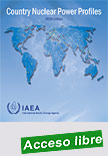 |
Country Nuclear Power Profiles
IAEA Non-serial Publications, 2016, s. p.
The Country Nuclear Power Profiles compile background information on the status and development of nuclear power programmes in Member States. The publication summarizes organizational and industrial aspects of nuclear power programmes and provides information about the relevant legislative, regulatory and international framework in each State. Its descriptive and statistical overview of the overall economic, energy and electricity situation in each State and its nuclear power framework is intended to serve as an integrated source of key background information about nuclear power programmes throughout the world. This 2016 edition, issued on CD-ROM, contains updated country information for 51 States.
|
Extraído de: http://pub.iaea.org/books/IAEABooks/11127/Country-Nuclear-Power-Profiles
|
 |
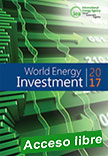 |
The second annual IEA benchmark analysis of energy investment – the lifeblood of the global energy system – presents diverse findings, with upbeat news in some quarters and bearish indicators in others.
World Energy Investment 2017 provides a critical foundation for decision making by governments, the energy industry and financial institutions.
|
With analysis of the past year’s developments across all fuels and all energy technologies, the report reveals the critical issues confronting energy markets and features the emerging themes for 2017 and beyond. It highlights the ways in which investment decisions taken today are determining how energy supply and demand will unfold tomorrow, complementing the forecasts and projections found in other IEA publications.
This year’s edition examines the financial landscape for energy investment and how financing flows are evolving in relation to renewable energy expansion, shorter-cycle oil and gas projects, and innovations in energy efficiency financing.
World Energy Investment 2017 addresses key questions, including:
- Which countries and policies attracted the most energy investment in 2016?
- Investments are growing the fastest in which fuels and technologies?
- How are oil and gas companies reinventing themselves to survive the new technology and price environments in the sector?
- How might energy investment trends affect energy security and climate change mitigation?
- How are business models evolving with the changing availabilities of capital for different energy sources?
- What are governments and the energy sector spending on energy R&D, and who are the biggest spenders?
Extraído de: http://www.iea.org/bookshop/759-World_Energy_Investment_2017
Executive Summary: http://www.iea.org/Textbase/npsum/WEI2017SUM.pdf
|
 |
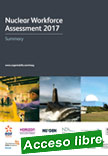 |
2017 Nuclear Workforce Assessment (NWA) - Summary
Nuclear Skills Strategy Group’s (NSSG’s – UK), July 2017, 18 p.
Today sees the launch of the Nuclear Skills Strategy Group’s (NSSG’s) 2017 Nuclear Workforce Assessment (NWA), the nuclear sector’s annual forecast of skills supply and demand across the sector through to 2021. The NSSG is the UK’s lead strategic skills forum for the sector. |
This comprehensive and regularly updated data underpins the sector’s workforce planning activity, as it enters its new build renaissance. It is aimed at ensuring the NSSG and the wider sector has the evidence required to develop the plans which deliver the right skills, in the right place and the right time. It also embraces the entirety of the sector including new build, operations, decommissioning, research and defence activities.
This latest NSSG NWA is now entirely sponsored by the NSSG member organisations and key partners. They see this clear ownership, alongside their own contribution of refreshed data, as being critical to improving understanding of sector skills requirements.
Extraído de: http://www.cogentskills.com/nssg/nssg-news/2017-nuclear-workforce-assessment-launched/
|
 |
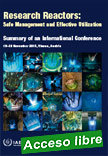
|
Research Reactors: Safe Management and Effective Utilization
Summary of an International Conference Held in Vienna, 16–20 November 2015
IAEA Proceedings Series, 2017, 66 p.
The International Conference on Research Reactors: Safe Management and Effective Utilization was organized by the IAEA and held in Vienna on 16–20 November 2015. The fifth and largest of its kind, it is regarded as the major networking event for the research reactor community worldwide. |
Research reactor organizations need to address challenges such as: the management of ageing of facilities and staff; the more effective and efficient
utilization of the facilities to justify operation and maintenance costs; the need to enhance regulatory effectiveness and to address the relevant lessons learned from the Fukushima Daiichi nuclear accident; the security of fuel supply and the management of spent fuel; the need for increased vigilance to prevent malicious acts; and the strain of shrinking resources, both financial and human, while fulfilling an expanding role in support of nuclear science and technology development. New research reactor projects also challenge Member States in developing their national infrastructure and human resources to ensure successful implementation. The conference provided a forum at which reactor operators, managers, users, regulators, designers and suppliers could all share experience and lessons learned, as well as address common issues, challenges and strategies.
Extraído de: http://pub.iaea.org/MTCD/Publications/PDF/Pub1793_web.pdf
|
 |
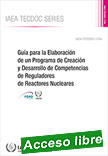 |
Guía para la Elaboración de un Programa de Creación y Desarrollo de Competencias de Reguladores de Reactores Nucleares
IAEA TECDOC, 2016, 124 p.
La “Guía para la Elaboración de un Programa de Creación y Desarrollo de Competencias de Reguladores de Reactores Nucleares” se propone presentar los lineamientos de un programa para el fortalecimiento de las competencias reguladoras, fundado en la experiencia operativa de los países con desarrollo nuclear que integran el FORO, y diseñado de manera tal que maximiza el empleo de recursos propios de la región iberoamericana.
|
La Guía aporta elementos concretos que pretenden constituir ayudas para el desarrollo de aspectos específicos de dicho programa que se consideran de interés especial. Dichos elementos de ayuda están basados en los análisis y ejercicios desarrollados en el ámbito del proyecto CReAN y en un conjunto de buenas prácticas identificadas en diferentes países. Pueden tomarse, de forma completa o parcial, como orientaciones prácticas o como ejemplos ilustrativos.
Se espera, por tanto, que las recomendaciones recopiladas en esta Guía puedan ser utilizadas en mayor o menor medida por los órganos reguladores de los países del FORO (Argentina, Brasil, Chile, Colombia, Cuba, España, México, Perú y Uruguay), por otros organismos de la región iberoamericana o por cualquier otro país en el desarrollo de su programa nacional. La aplicabilidad en cada país será variable, en función de la naturaleza y alcance de su programa nuclear y del grado de implantación y desarrollo de estrategias nacionales para la creación y gestión de competencias reguladoras previamente establecidas.
Extraído de: http://pub.iaea.org/MTCD/Publications/PDF/TE-1794_S_web.pdf
|
 |
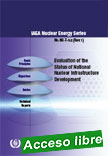 |
Evaluation of the Status of National Nuclear Infrastructure Development
IAEA Nuclear Energy Series, 2016, 69 p..
This publication provides a holistic approach to evaluate progress in the development of the nuclear power infrastructure based on the guidance contained in the IAEA Nuclear Energy Series No. NG-G-3.1, Milestones in the Development of a National Infrastructure for Nuclear Power. |
It can be used by a Member State itself, wishing to evaluate its progress (self-evaluation), or as a basis for an integrated nuclear infrastructure review (INIR) mission. This revised version combines in one document an explanation of the methodology and the evaluation tables, takes into account all new material and lessons learned from the Fukushima Daiichi accident, and presents the results of the INIR missions implemented between 2009 and 2014.
Extraído de: http://pub.iaea.org/books/IAEABooks/10955/Evaluation-of-the-Status-of-National-Nuclear-Infrastructure-Development
|
 |
|
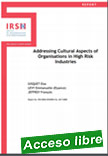
|
Appréhender les aspects culturels des organisations dans les industries à risques
Institut de Radioprotection et de Sûreté Nucléaire, 23/09/2016, 49 p.
L’IRSN présente les résultats d’une étude engagée par son laboratoire de recherche en sciences humaines et sociales, relative à l’usage des notions de « culture de sûreté » et de « culture » dans les évaluations de sûreté des installations nucléaires.
|
La notion de Culture de sûreté est au cœur de nombreuses démarches visant à améliorer la sûreté des installations nucléaires. En particulier, l’Agence Internationale de l'Energie Atomique (AIEA) en a fait un élément central de sa stratégie de développement de la prise en compte des facteurs organisationnels et humains. Dans ce cadre, l’IRSN a principalement inscrit ses évaluations et ses recherches dans des courants théoriques issus de l’ergonomie et de la sociologie des organisations.
Si cette orientation a permis de formuler des avis documentés, il apparaît nécessaire de mieux prendre en compte les dimensions culturelles, car certaines d’entre elles contribuent à la maîtrise des risques. Elles peuvent par exemple être partie prenante de dispositions destinées à favoriser la coopération entre métiers différents (maintenance et conduite, exploitation et démantèlement, exploitation et recherche, etc.), entre structure projet et organisation pérenne (management des arrêts de tranche, implantation de modifications, chantiers de démantèlement, etc.), entre entreprises (relations entre donneur d’ordre et prestataires).
L’IRSN a donc réalisé une étude visant à définir des orientations concernant l’usage des notions de « culture » et de « culture de sûreté » dans les évaluations de sûreté des installations nucléaires. Dans un premier temps, les apports et limites de la notion sont identifiés, ce qui conduit dans un deuxième temps, à relire les principaux travaux concernant la culture qui ont été menés en anthropologie, sociologie, sciences de gestion et ergonomie. Ces recherches montrent que la prise en compte des dimensions culturelles peut donner accès à des phénomènes peu saisissables par d’autres grilles d’analyse des organisations. Sur cette base, quatre plans d’analyse ont été définis qui proposent une décomposition de l’objet global « culture » : cultures organisationnelles, cultures professionnelles, cultures et relations sociales, cultures nationales. Dans la quatrième partie du document, ces plans d’analyse sont mobilisés pour revisiter des évaluations de sûreté réalisées dans le passé. Ce faisant, les rapports entre les dimensions culturelles et la sûreté sont précisés et l’intérêt de leur prise en compte est confirmé.
Extraído de: http://www.irsn.fr/FR/expertise/rapports_expertise/surete/Pages/Aspects-culturels-organisations-industries-risques_2016.aspx#.WJxQwW8rK70
|
 |
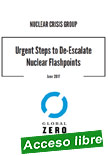 |
Urgent Steps to De-Escalate Nuclear Flashpoints
Nuclear Crisis Group, June 2017, 11 p.
In response to the alarming and continued rise of geopolitical tensions involving nuclear-armed states and their allies, Global Zero has launched the Nuclear Crisis Group (NCG), consisting of national security experts and former senior officials from ten countries, including the United States, Russia, China, Japan, South Korea, India and Pakistan.
|
The Group began its work in May 2017 by reviewing the situation in potential nuclear flashpoints and concluded that the risks of nuclear weapons use — intentional or otherwise — are unacceptably and unnecessarily high and require urgent leadership and global action. The Group then developed and unanimously endorsed a set of steps for national governments to pursue to reduce
nuclear risks.
These recommended steps, found below, center on improving direct communications among states where conflict can quickly escalate to the nuclear level. This includes immediately starting direct, bilateral USDPRK discussions that could proceed in parallel to efforts to restart denuclearization negotiations through the Six-Party process. To address the nuclear risks between Washington and Moscow, the Nuclear Crisis Group welcomes the decision by US Secretary of State Rex Tillerson and Russian Foreign Minister Sergey Lavrov to resume strategic stability talks and urges the two states to begin that process quickly and reduce
the risk of miscalculation and escalation. All of these steps, outlined below, are achievable with sufficient political will, and the Group is prepared to provide our public support in these efforts.
Extraído de: https://globalzero.org/files/nuclear_crises_group_urgent_steps_june_2017.pdf
|
 |
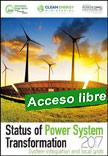 |
Status of Power System Transformation 2017
International Energy Agency (IEA), 2017, 158 p.
Power sectors around the world are undergoing significant change due to the rapid uptake of new supply- and demand-side technologies. In particular, large-scale wind and solar power as well as distributed energy resources are influencing the planning, operation and profitability of power systems.In response, policymakers, utilities and other stakeholders need to apply innovative approaches to transform the power system, with the objective to achieve sustainable, affordable and reliable electricity.
|
|
 |
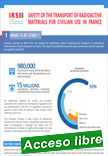 |
Safety of the Transport of Radioactive Materials for Civilian Use in France. Lessons learned by IRSN from analysis of significant events reported in 2014 and 2015
Institut de Radioprotection et de Sûreté Nucléaire (IRSN), 09/03/2017, 44 p.
IRSN publishes its report on the safety of transport of radioactive materials for civilian use in France for the years 2014 and 2015. It is based on an overall review of the significant events that occurred during this period during transport operations in France by road, railway, inland waterway, sea and air of 980 000 parcels loaded with radioactive substances.
|
.
Extraído de: http://www.irsn.fr/EN/publications/technical-publications/Pages/technical-safety.aspx
|
 |
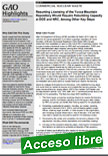 |
Commercial Nuclear Waste: Resuming Licensing of the Yucca Mountain Repository Would Require Rebuilding Capacity at DOE and NRC, Among Other Key Steps
Government Accountability Office (GAO - US), April 26, 2017, 53 p.
Spent nuclear fuel from comercial power reactors can pose risks to humans and the environment, if not properly contained, and is a source of billions of dollars of liabilities. In 2008, DOE applied to NRC for approval to build a geologic repository at Yucca Mountain in Nevada for permanent disposal of spent nuclear fuel and highlevel waste.
|
As part of NRC’s licensing process to review DOE’s application and potentially approve construction, NRC initiated a public hearing—or adjudication—with DOE, NRC staff, and nonfederal parties. However, in March 2010, after announcing plans to terminate its proposal for Yucca Mountain, DOE submitted a motion to NRC to withdraw its application. In September 2011, NRC formally suspended the adjudication.
GAO was asked to examine the likely steps needed to resume the Yucca Mountain licensing process. This report examines (1) the actions that took place after DOE submitted its motion to withdraw its application and any plans by DOE or NRC to resume the licensing process, and (2) the likely key steps needed to resume and complete the process and the factors that may influence these steps’ success.
GAO reviewed federal laws and documents; interviewed DOE and NRC officials and contractors; and interviewed or received written remarks from 15 of the 17 nonfederal parties.
.
Extraído de: http://www.gao.gov/assets/690/684326.pdf
Home-page: http://www.gao.gov/products/GAO-17-340
Highlights: http://www.gao.gov/assets/690/684326.pdf
|
 |
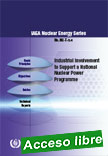 |
Industrial Involvement to Support a National Nuclear Power Programme
IAEA Nuclear Energy Series, 2016, 66 p.
This publication, an update of Technical Reports Series No. 281, provides guidance in making the many considerations and decisions involved in preparing national industrial organizations for participation in a nuclear power programme, including those that will participate in the construction and commissioning of the first nuclear power plant units. Roles and responsibilities of government, industry, utility and other stakeholders are detailed.
|
.
Extraído de: http://pub.iaea.org/books/IAEABooks/10825/Industrial-Involvement-to-Support-a-National-Nuclear-Power-Programme |
 |
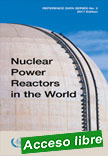 |
Nuclear Power Reactors in the World - 2017 Edition
IAEA Reference Data Series, 2017, 79 p.
This is the 37th edition of Reference Data Series No. 2, which presents the most recent reactor data available to the IAEA. It contains summarized information as of the end of 2016 on power reactors operating, under construction and shut down as well as performance data on reactors operating in the IAEA Member States. The information is collected through designated national correspondents in the Member States and the data are used to maintain the IAEA's Power Reactor Information System (PRIS).
|
Extraído de: http://pub.iaea.org/books/IAEABooks/12237/Nuclear-Power-Reactors-in-the-World |
 |
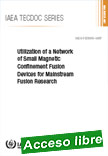 |
Utilization of a Network of Small Magnetic Confinement Fusion Devices for Mainstream Fusion Research
IAEA TECDOC, 2016, 184 p.
Small magnetic confinement fusion devices have played and continue to play an important role in fusion research. Thanks to their compactness, flexibility and low operation costs, they can support scientific and technology developments, modelling analysis, and training and education.
|
This publication presents the outcome of an IAEA coordinated research project (CRP) on utilisation of a network of small magnetic confinement fusion devices for mainstream fusion research and reports on the research work accomplished within the framework of the project. It presents the contribution of these devices in research in a wide range of areas such as plasma confinement and energy transport, plasma stability in different magnetic configurations, plasma turbulence and its impact on local and global plasma parameters, processes at the plasma edge and plasma-wall interaction, scenarios with additional heating and non-inductive current drive.
Extraído de: http://pub.iaea.org/books/IAEABooks/11144/Utilization-of-a-Network-of-Small-Magnetic-Confinement-Fusion-Devices-for-Mainstream-Fusion-Research |
 |
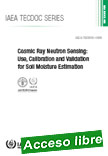 |
Cosmic Ray Neutron Sensing: Use, Calibration and Validation for Soil Moisture Estimation
IAEA TECDOC, 2017, 48 p
Nuclear and related techniques can help develop climate-smart agricultural practices by optimizing water use efficiency. The measurement of soil water content is essential to improve the use of this resource in agriculture. However, most sensors monitor small areas (less than 1m in radius), hence a large number of sensors are needed to obtain soil water content across a large area.
|
This can be both costly and labour intensive and so larger scale measuring devices are needed as an alternative to traditional point-based soil moisture sensing techniques. The cosmic ray neutron sensor (CRNS) is such a device that monitors soil water content in a non-invasive and continuous way. This publication provides background information about this novel technique, and explains in detail the calibration and validation process.
Extraído de: http://pub.iaea.org/books/IAEABooks/11097/Cosmic-Ray-Neutron-Sensing-Use-Calibration-and-Validation-for-Soil-Moisture-Estimation |
 |
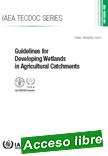 |
Guidelines for Developing Wetlands in Agricultural Catchments
IAEA TECDOC, 2017, 68 p
This publication presents the results of an international research project, organized by the Joint FAO/IAEA Division of Nuclear Techniques in Food and Agriculture on optimizing the capture and storage of water by assessing nutrient using water conservation zones in agricultural landscapes. Eight countries from Asia-Pacific, Africa and Europe participated in the project.
|
Field studies were established in all participating countries using isotopic and nuclear techniques to assess three types of water conservation zones that are used to harvest water for irrigation, crop production and improve downstream water quality. In addition, isotopic and nuclear techniques were used to collect data to identify the ideal locations in the landscapes for developing wetlands. The publication provides information to researchers working in the area of soil and water management, natural resource managers, policy makers and farmers. For those working to develop wetlands, information is provided to support planning, monitoring and evaluation.
Extraído de: http://pub.iaea.org/books/IAEABooks/11146/Guidelines-for-Developing-Wetlands-in-Agricultural-Catchments |
| |
| |
|
|
| |
| |
|
|
| |
| |
|
|
| |
| |
|
|
|
|
|
|
|
